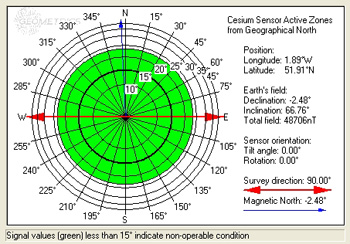Caesium Active Zones Program
All current-generation optically pumped magnetometers have areas of insensitivity. If the Earth’s magnetic field vector passes through this zone, known as a “dead zone,” the sensor will be unable to measure the magnetic field’s strength.

In Geometrics’ current generation of Caesium sensors, dead zones form a cone with a ½ angle of 8° around both the long axis and the equator of the sensor. This results in an active zone of approximately 76°, measured from the polar axis to the equator, through which the Earth’s magnetic field vector must pass to ensure an accurate measurement.
When surveying with a magnetometer using optically pumped sensors, it’s crucial to ensure proper sensor orientation to prevent data dropouts while traversing a survey line. Since the dip angle of the Earth’s magnetic field varies by geographic location, determining the correct sensor orientation during pre-survey planning can be challenging.
To assist with this, Geometrics offers the Caesium Active Zone program (CSAZ), a free tool compatible with Windows. By simply entering your latitude and longitude, CSAZ will display the optimal surveying direction and demonstrate how sensor orientation adjustments impact the signal-to-noise ratio, helping you achieve the best possible results in your magnetic survey.
Download Caesium Active Zones Program ( ZIP 1MB )
